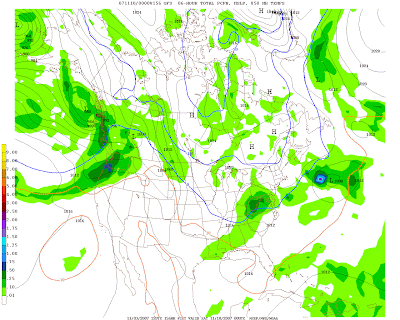 Precipitation Forecast:
Precipitation Forecast:Over the years, the ENSO (El Niño-Southern Oscillation) Index has been used, to great effect, to predict long term inter-seasonal variability in temperature anomalies across the United States. Generally, La Niña occurs when Sea Surface Temperature Anomalies from an area bounded from 5°N-5°S 120°W-170°W (also known as Niño 3.4) drop to less than 0.5 degrees Celsius.
Boxed areas represent the so-called Niño regions. Niño 3.4 is generally used in most long-term forecasts. Image courtesy of the Climate Prediction Center
At the end of the August-September-October time period, Niño 3.4 was at -0.8 and falling, meaning average SST anomalies for that region were 0.8 degrees Celsius below normal. Model forecast for the ENSO index indicate that SSTs should continue to fall through the remainder of the year and into next January. The NCEP CFS model, in particular, drops the ENSO index down below -2, which would approach some of the lowest monthly values every recorded.

 More likely, however, is the threat of a moderate to strong La Niña through next January which would indicate drier than normal conditions across the Southeast and Mid Atlantic States, and generally warmer than average temperatures.
More likely, however, is the threat of a moderate to strong La Niña through next January which would indicate drier than normal conditions across the Southeast and Mid Atlantic States, and generally warmer than average temperatures.La Niña generally predicts precipitation anomalies a little better than temperature anomalies, at least in this part of the United States, so I am using the ENSO index more for this aspect of the winter forecast.
In short, I anticipate a drier-than-normal period from December through next January for the entire Southeast and Mid Atlantic. (This could be a bad thing for you snow-lovers, but keep reading).
Temperature Forecast:
Temperatures are normally a little harder to predict this far in advance. Unlike the teleconnections for precipitation, the comparisons aren't as black and white. Temperatures can be affected by the position of the jet stream, North Atlantic Oscillation, Pacific/North American Pattern, the Arctic Oscillation, Southern Oscillation Index, and a list that goes on too long to complete.

As a rule, though, the North Atlantic Oscillation (NAO) and Pacific/North American Pattern (PNA) are the most reliable predictors of temperature anomalies.
The NAO index, which measures pressure differentials between areas around Greenland, is currently at 0.45 and falling slowly. Likewise the PNA was 0.55 and falling rapidly. The years that best represented our current set-up are: 1963, 1969, 1995, and 2005. These years produced below-normal temperature anomalies across the Eastern third of the country, as seen at right.
Based on this information, and combining it with the fact that the ENSO should be negative for much of the winter, I think temperatures will be average to slightly below average through January.
Snowfall:
With La Niña in place, we will likely not be seeing an above average year for snowfall. However, I think we may be able to squeeze out a slightly below average year for most of the area (that works out to be around 10-14 inches at Reagan National, and 13-16 inches up north towards Baltimore. There will likely be more storms that drop a mixture of snow, rain, and freezing rain over the Mid Atlantic due to the milder air.







